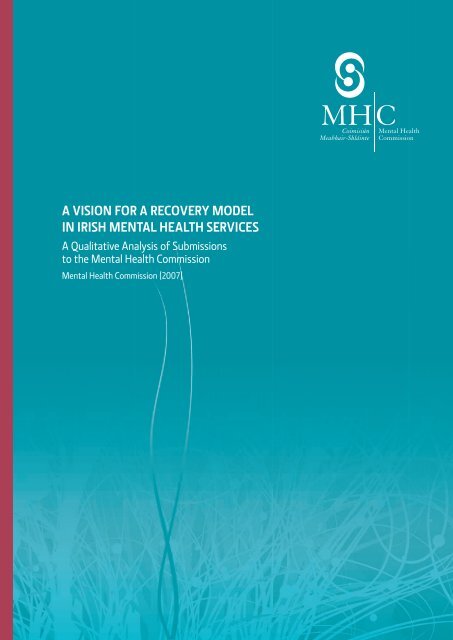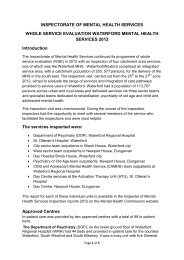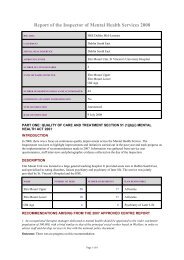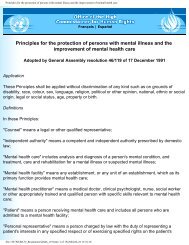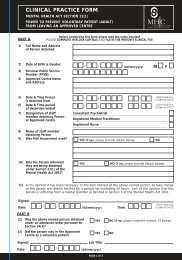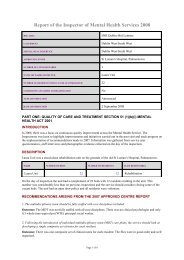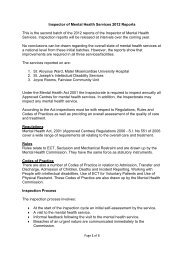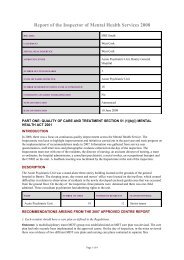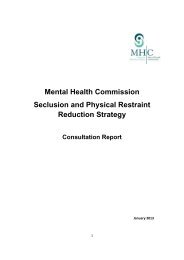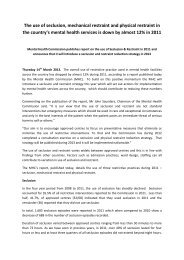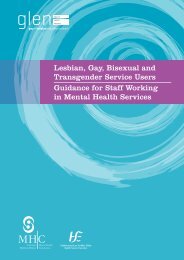a vision for a recovery model in irish mental health services
a vision for a recovery model in irish mental health services
a vision for a recovery model in irish mental health services
Create successful ePaper yourself
Turn your PDF publications into a flip-book with our unique Google optimized e-Paper software.
A Qualitative Analysis of Submissions to the Mental Health Commission on the Discussion PaperA Vision <strong>for</strong> a Recovery Model <strong>in</strong> Irish Mental Health ServicesList of TablesTable 1: Questions <strong>for</strong> facilitat<strong>in</strong>g discussion on the <strong>recovery</strong> <strong>model</strong> 5Table 2: Number of Responses by Type of Respondent 6Table 3: Frequencies of Respondents Aware of Use of Recovery Model/Recovery Pr<strong>in</strong>ciples 9Table 4: Key programmes highlighted as be<strong>in</strong>g <strong>recovery</strong> <strong>model</strong> orientated 10Table 5: Frequencies of Key Themes <strong>for</strong> Response to Question 3 12Table 6: Frequencies of Key Themes <strong>for</strong> Response to Question 4 15Table 7: Frequencies of Key Themes <strong>for</strong> Response to Question 5 19Table 8: Frequencies of Key Themes <strong>for</strong> Response to Question 6 214
A Qualitative Analysis of Submissions to the Mental Health Commission on the Discussion PaperA Vision <strong>for</strong> a Recovery Model <strong>in</strong> Irish Mental Health ServicesAim and ContextA discussion paper titled A Vision <strong>for</strong> a Recovery Model <strong>in</strong> Irish Mental Health Services wascirculated to various stakeholders throughout Ireland. The purpose of this paper was toencourage and <strong>in</strong><strong>for</strong>m debate on the <strong>recovery</strong> <strong>model</strong>. Stakeholders were <strong>in</strong>vited to considerthe issues that were raised <strong>in</strong> the discussion document and to share their views with theMental Health Commission. Specifically, stakeholders were asked to respond to sevenspecific questions (see Table 1 below). The aim of this discrete report was to provide aqualitative analysis of these submissions.Table 1: Questions <strong>for</strong> Facilitat<strong>in</strong>g Discussion on the Recovery Model1 Do you th<strong>in</strong>k the <strong>recovery</strong> <strong>model</strong> is relevant to the Irish <strong>mental</strong> <strong>health</strong> <strong>services</strong>?2 Do you know of any area with<strong>in</strong> the <strong>mental</strong> <strong>health</strong> <strong>services</strong> where the <strong>recovery</strong> <strong>model</strong>is used?3 In your view what are the barriers to promot<strong>in</strong>g the <strong>recovery</strong> <strong>model</strong> with<strong>in</strong> the Irish<strong>mental</strong> <strong>health</strong> <strong>services</strong>?4 In your view what are the factors that will facilitate the <strong>recovery</strong> <strong>model</strong> with<strong>in</strong> theIrish <strong>mental</strong> <strong>health</strong> <strong>services</strong>?5 What, <strong>in</strong> your view, is the s<strong>in</strong>gle factor that would promote <strong>recovery</strong> <strong>in</strong> our <strong>mental</strong><strong>health</strong> <strong>services</strong>?6 What is your view of user-self-management programmes <strong>in</strong> <strong>mental</strong> <strong>health</strong> as havebeen developed <strong>for</strong> physical illnesses?7 Any other comments on the discussion paper?5
A Qualitative Analysis of Submissions to the Mental Health Commission on the Discussion PaperA Vision <strong>for</strong> a Recovery Model <strong>in</strong> Irish Mental Health ServicesMethodParticipants:A total of 68 responses were submitted to the Mental Health Commission by variousstakeholders to the discussion paper <strong>for</strong> analysis. A breakdown of the type of respondentsby number of responses is displayed <strong>in</strong> Table 2 below.Table 2: Number of Responses by Type of Respondent (percentages <strong>in</strong> parentheses)Professional Group<strong>in</strong>gNo. ofIndividualResponsesHSE/Independent Provider 16(23.5)Professional Body 6(8.8)Advocacy/Voluntary Organisation 11(16)Academic/Research Organisation 9(13.2)No. of GroupResponses21(30.9)1(1.4)1(1.4)Vocational Services - 3(4.4)Total 41(60.3)Total No. ofResponses37(54.4)7(10.2)- 11(16.2)10(14.7)3(4.4)27(39.7) 686
A Qualitative Analysis of Submissions to the Mental Health Commission on the Discussion PaperA Vision <strong>for</strong> a Recovery Model <strong>in</strong> Irish Mental Health ServicesGeneral Approach to Analysis:Content analysis was used to identify the key themes evident <strong>in</strong> the submissions <strong>for</strong>each question (see Table 1). This <strong>in</strong>volved review<strong>in</strong>g the transcripts to identify commonthreads, which where then sorted <strong>in</strong>to mutually exclusive themes. Us<strong>in</strong>g these themes as aframework, a frequency analysis was carried out on the transcripts as a whole to determ<strong>in</strong>ehow many stakeholders referred to each theme <strong>in</strong> their submission. In order to highlightthese themes, quotes are selected and <strong>in</strong>cluded to reflect the nature of the perspectivesaround each theme. As it is not possible to <strong>in</strong>clude all quotes relat<strong>in</strong>g to a specific theme,samples are selected to offer the reader an <strong>in</strong>sight <strong>in</strong>to the discussions.In addition to the thematic analysis <strong>for</strong> each question posed by the Mental HealthCommission, the analysis also set out to identify any major criticisms or suggestions <strong>for</strong>improvement <strong>in</strong> the transcripts made by respondents, which were not addressed <strong>in</strong> theanalysis of each question.Given that there are a high number of both <strong>in</strong>dividual and group submissions by the HSE/Independent Provider (see Table 2), the responses <strong>for</strong> these two sub-categories will beconsidered separately <strong>in</strong> the analysis. That is, submissions from the HSE/IndependentProvider will be separated <strong>in</strong>to the sub-categories; HSE/Independent Provider Group andHSE/Independent Provider Individual. The <strong>in</strong>dividual and group responses will be consideredas one s<strong>in</strong>gle category <strong>for</strong> each of the rema<strong>in</strong><strong>in</strong>g types of respondents.7
A Qualitative Analysis of Submissions to the Mental Health Commission on the Discussion PaperA Vision <strong>for</strong> a Recovery Model <strong>in</strong> Irish Mental Health ServicesResultsThe follow<strong>in</strong>g sections outl<strong>in</strong>e the f<strong>in</strong>d<strong>in</strong>gs of the thematic analysis. For most of the questionsto be addressed, a table of frequencies highlight<strong>in</strong>g the key themes is first provided. Then adescription of the themes is presented. Throughout the report<strong>in</strong>g of the results, referenceis made to any particularly <strong>in</strong>sightful or detailed submission. In addition, emphasis is placedon particular strength of feel<strong>in</strong>g among any given groups that may have emerged <strong>in</strong> analysisof the submission responses.Question 1: Do you th<strong>in</strong>k the <strong>recovery</strong> <strong>model</strong> is relevant to the Irish<strong>mental</strong> <strong>health</strong> <strong>services</strong>?The vast majority of respondents (n=61, 89.7%) clearly stated their op<strong>in</strong>ion that the <strong>recovery</strong><strong>model</strong> is relevant to the Irish <strong>mental</strong> <strong>health</strong> <strong>services</strong>. The rema<strong>in</strong>der (n=7; 10.3%) did not directlyanswer the question or explicitly state their op<strong>in</strong>ion on the relevance of the <strong>model</strong> (Theseparticular respondents were mostly psychiatry consultant <strong>in</strong>dividual or team submissions).What follows is a number of suggestions and criticisms raised <strong>in</strong> the responses to thequestion by respondents that were identified as significant <strong>in</strong> the analysis.Concern was expressed over the use of the word ‘<strong>model</strong>’. The terms “philosophy” and“approach” were each offered as a preferred term to <strong>model</strong>. (“An area of concern to us isuse of the word “<strong>model</strong>” <strong>in</strong> the description of this approach to care. We would see it moreas an approach to care and believe that the use of the word <strong>model</strong> creates the potential<strong>for</strong> confusion with other more def<strong>in</strong>ed scientific approaches to care such as nurs<strong>in</strong>g andmedical <strong>model</strong>s”).A small number of submissions highlighted that the <strong>recovery</strong> approach to care has beenaround <strong>for</strong> a number of years. Many of the pr<strong>in</strong>ciples highlighted <strong>in</strong> the discussion paperhave been <strong>in</strong> the <strong>in</strong>terventions and support systems of many <strong>services</strong> but they have notbeen titled as ‘<strong>recovery</strong> oriented’ <strong>in</strong> a <strong>for</strong>mal way (“Many of the pr<strong>in</strong>ciples of the <strong>recovery</strong><strong>model</strong> are already <strong>in</strong>corporated <strong>in</strong> many <strong>mental</strong> <strong>health</strong> <strong>services</strong> help<strong>in</strong>g those with bothacute and cont<strong>in</strong>u<strong>in</strong>g <strong>mental</strong> <strong>health</strong> needs. The importance of plac<strong>in</strong>g the person/serviceuser at the centre of their management plan is undisputed and already takes place to alarge extent with<strong>in</strong> <strong>services</strong>”).Suggestions were made to conduct a <strong>for</strong>mal survey to determ<strong>in</strong>e to what extent (1) the<strong>recovery</strong> <strong>model</strong> is already <strong>in</strong> operation <strong>in</strong> Irish <strong>mental</strong> <strong>health</strong> <strong>services</strong> and (2) the <strong>recovery</strong>based competencies identified on p.27 of the paper actually <strong>for</strong>m part of professionaleducational preparation.8
A Qualitative Analysis of Submissions to the Mental Health Commission on the Discussion PaperA Vision <strong>for</strong> a Recovery Model <strong>in</strong> Irish Mental Health ServicesClarity over how exactly the <strong>model</strong> would be put <strong>in</strong>to operation was called <strong>for</strong>. This wasparticularly the case <strong>for</strong> respondents who did not explicitly agree with the relevance of the<strong>model</strong>. A suggestion was made to provide details to stakeholders of how the <strong>model</strong> couldbe implemented <strong>in</strong> practical terms. With such <strong>in</strong><strong>for</strong>mation stakeholders would be <strong>in</strong> a betterposition to <strong>for</strong>m a constructive op<strong>in</strong>ion over the relevance of the <strong>model</strong>.Question 2: Do you know of any area with<strong>in</strong> the <strong>mental</strong> <strong>health</strong> <strong>services</strong>where the <strong>recovery</strong> <strong>model</strong> is used?The key frequencies of themes highlighted <strong>for</strong> responses to Question 2 are presented <strong>in</strong>Table 3 below.Table 3: Frequencies of Respondents Aware of Use of Recovery Model/Recovery Pr<strong>in</strong>ciples (percentages <strong>in</strong> parentheses)HSE /Ind GrHSE/Ind IndividProfessional BodyAdvocacy/Voluntary AgencyResearch/AcademicVocationalTotalFormal Programmes that Implicitlyor Explicitly Adopt Pr<strong>in</strong>ciples ofRecovery4(19)3(18.8)2(28.6)1(9)5(50)3(100)18(26.5)Services that Adopt Pr<strong>in</strong>ciples ofRecovery6(28.6)5(31.3)3(42.9)5(45.5)1(10)1(33.3)21(30.1)Discipl<strong>in</strong>es that Adopt Pr<strong>in</strong>ciples 5(23.8)1(6.3)2(28.6)- - - 8(11.8)9
A Qualitative Analysis of Submissions to the Mental Health Commission on the Discussion PaperA Vision <strong>for</strong> a Recovery Model <strong>in</strong> Irish Mental Health ServicesThe analysis of responses to Question 2 revealed three ma<strong>in</strong> themes. To beg<strong>in</strong> with, emphasiswas placed on <strong>for</strong>mal programmes that adopt the pr<strong>in</strong>ciples of the <strong>recovery</strong> <strong>model</strong> eitherexplicitly or implicitly. A list of the programmes referred to <strong>in</strong> the responses is displayed <strong>in</strong>Table 4 below. Multiple references were made to both the WRAP and the Tidal <strong>model</strong> (TheCommission is referred to a particular submission 1 <strong>for</strong> details on the Tidal <strong>model</strong>). For therema<strong>in</strong><strong>in</strong>g programmes listed <strong>in</strong> Table 4 only one reference was made to each throughoutthe submissions.Table 4: Key Programmes Highlighted as Be<strong>in</strong>g Recovery Model OrientatedProgrammeLocation/ServiceProviderKey Figures/DepartmentsOther DetailsWRAP(Wellness RecoveryAction Programme)Mid-West: Clare MentalHealth ServicesSouth Dubl<strong>in</strong>: Clua<strong>in</strong>Mhuire ServiceOccupationalTherapy DepartmentSocial WorkDepartmentTidal ModelMayo Mental HealthServicesMary McHalewww.tidal-<strong>model</strong>.co.ukCork Mental HealthServices:Tosnu TeamRavenscourt HospitalAnn CoughlanMichael CottrellTr<strong>in</strong>ity College Dubl<strong>in</strong>Professor PJ Barker,School of Nurs<strong>in</strong>gand MidwiferyUni-L<strong>in</strong>k Programme Tr<strong>in</strong>ity College Dubl<strong>in</strong> Clodagh Nolan,School ofOccupationalTherapyTuras ProgrammeAdvocacy, Supportand DevelopmentCourseDonegal Mental HealthServicesSoutheast AreaWater<strong>for</strong>d Institute ofTechnologyFosters communityparticipation, wellness,autonomy and selfmanagementProvides skills <strong>for</strong>volunteers (mostlyservice users or familymembers/carers ofpersons suffer<strong>in</strong>g from<strong>mental</strong> <strong>health</strong> illness)1P.J. Barker, School of Nurs<strong>in</strong>g and Midwifery, TCD.10
A Qualitative Analysis of Submissions to the Mental Health Commission on the Discussion PaperA Vision <strong>for</strong> a Recovery Model <strong>in</strong> Irish Mental Health ServicesREACH programme(Recognition andEsteem thoughAccommodation,Cater<strong>in</strong>g andHorticulture)CBT-based “Liv<strong>in</strong>gWell with Psychosis”.Work-l<strong>in</strong>k/Create-al<strong>in</strong>kSouth East CountyDubl<strong>in</strong>South Dubl<strong>in</strong>: Clua<strong>in</strong>Mhuire ServiceDonegal Mental HealthServiceFASPsychologyDepartmentSecondly, a number of submissions mentioned <strong>services</strong> they knew of that adopt the pr<strong>in</strong>ciplesof <strong>recovery</strong> <strong>in</strong> their practice with service users (“The philosophical elements of <strong>recovery</strong> arenot new and are already used by self-help groups and peer organisations”). Both voluntaryagencies and HSE/Independent Provider <strong>services</strong> were highlighted <strong>in</strong> this regard (“Voluntaryagencies such as Schizophrenia Ireland, EVE Ltd and the National Learn<strong>in</strong>g Network aremore familiar with (the <strong>recovery</strong>) <strong>model</strong>”; “West Cork Mental Health Service have developeda Mental Health Community Forum of service providers, service users, community activitiesand voluntary agencies as part of a <strong>recovery</strong> orientated ethos of care”).There was a general awareness that elements of the <strong>recovery</strong> <strong>model</strong> are <strong>in</strong>corporated <strong>in</strong><strong>in</strong>dividual work<strong>in</strong>g practices <strong>in</strong> the <strong>mental</strong> <strong>health</strong> service but not of <strong>for</strong>mal approaches byorganisations of a <strong>recovery</strong> <strong>model</strong>. Mostly these were highlighted as aspirational towardsa <strong>recovery</strong> philosophy with such ef<strong>for</strong>ts be<strong>in</strong>g met with many frustrations <strong>in</strong> a prevail<strong>in</strong>gmedical <strong>model</strong>. Many have noted that the philosophy of the <strong>recovery</strong> <strong>model</strong> is graduallybe<strong>in</strong>g <strong>in</strong>troduced with the <strong>in</strong>troduction of new <strong>model</strong>s of community <strong>mental</strong> <strong>health</strong> <strong>services</strong>and rehabilitation <strong>services</strong> (“As new <strong>model</strong>s of community <strong>mental</strong> <strong>health</strong> service deliveryevolve, and dedicated rehabilitation <strong>services</strong> develop, the philosophy of the <strong>recovery</strong> <strong>model</strong>is gradually be<strong>in</strong>g <strong>in</strong>troduced”).F<strong>in</strong>ally, with<strong>in</strong> a number of submissions respondents drew attention to how the pr<strong>in</strong>ciples<strong>in</strong>herent <strong>in</strong> the <strong>recovery</strong> <strong>model</strong>, parallel those of their own professional discipl<strong>in</strong>e. Themajority of references to this theme were made by Occupational Therapists. OccupationalTherapists practis<strong>in</strong>g with<strong>in</strong> the <strong>mental</strong> <strong>health</strong> <strong>services</strong> primarily use one of two <strong>model</strong>s to<strong>in</strong><strong>for</strong>m practice (Canadian Occupational Per<strong>for</strong>mance Model (Law et al, 1990) or Model ofHuman Occupation (Kielhofner, 1985)). Both of these espouse pr<strong>in</strong>ciples that are <strong>in</strong> l<strong>in</strong>e withthe Recovery <strong>model</strong>.11
A Qualitative Analysis of Submissions to the Mental Health Commission on the Discussion PaperA Vision <strong>for</strong> a Recovery Model <strong>in</strong> Irish Mental Health ServicesQuestion 3: In your view what are the barriers to promot<strong>in</strong>g the <strong>recovery</strong><strong>model</strong> with<strong>in</strong> the Irish <strong>mental</strong> <strong>health</strong> <strong>services</strong>?Respondents were asked to highlight what they viewed as be<strong>in</strong>g the barriers to promot<strong>in</strong>gthe <strong>recovery</strong> <strong>model</strong> with<strong>in</strong> Irish <strong>mental</strong> <strong>health</strong> <strong>services</strong>. The most dom<strong>in</strong>ant themes thatemerged <strong>in</strong> the transcripts <strong>in</strong> response to this question are displayed <strong>in</strong> Table 5 below.Table 5: Frequencies of Key Themes <strong>for</strong> Response to Question 3 (percentages <strong>in</strong> parentheses)Key ThemesHSE /Ind GrHSE/Ind IndividProfessional BodyAdvocacy/Voluntary AgencyResearch/AcademicVocationalTotalDom<strong>in</strong>ance of Medical Model 15(71.4)4(25)1(14.3)2(18.2)4(40)2(67)26(38.2)Attitud<strong>in</strong>al: Public Op<strong>in</strong>ion/Stigma8(38)3(18.8)1(14.3)6(54.5)4(40)2(67)22(32.4)Attitud<strong>in</strong>al: Resistance fromService Providers9(42.9)5(31.3)- 1(9)3(30)1(33.3)14(20.6)Lack of Multidiscipl<strong>in</strong>ary Teams 9(42.9)4(25)1(14.3)2(18.2)- 1(33.3)13(19.1)Lack of Understand<strong>in</strong>g ofRecovery Model9(42.9)2(12.5)1(14.3)2(18.2)1(10)2(67)11(16.2)Lack of Evidence-basedResearch <strong>for</strong> Recovery Model5(23.8)5(31.3)2(14.3)1(9)1(10)1(33.3)10(14.7)(The Commission are referred to two submissions 2 that provide a comprehensive outl<strong>in</strong>e ofbarriers)The medical <strong>model</strong> emerged as the central theme. Submissions from each category ofrespondents referred to the dom<strong>in</strong>ance of the medical <strong>model</strong> when describ<strong>in</strong>g the barrierthat it creates to promot<strong>in</strong>g the <strong>recovery</strong> <strong>model</strong> (“the major barrier to promot<strong>in</strong>g [the<strong>recovery</strong> <strong>model</strong>] is the <strong>in</strong>flexibility of a paternalistic and powerful medical <strong>model</strong> which hasheld sway <strong>in</strong> determ<strong>in</strong><strong>in</strong>g the philosophical and practical direction of <strong>mental</strong> <strong>health</strong> <strong>services</strong><strong>for</strong> the past hundred years”).2Eastern Vocational Enterprises Ltd & Agnes Higg<strong>in</strong>s, School of Nurs<strong>in</strong>g and Midwifery, TCD.12
A Qualitative Analysis of Submissions to the Mental Health Commission on the Discussion PaperA Vision <strong>for</strong> a Recovery Model <strong>in</strong> Irish Mental Health ServicesThe lack of multidiscipl<strong>in</strong>ary teams was highlighted <strong>in</strong> the transcripts as a further barrier.Specifically, respondents made reference to the lack of “fully-developed” and “fullyresourced”multidiscipl<strong>in</strong>ary teams (“Promot<strong>in</strong>g <strong>recovery</strong> programmes requires properlyresourced multi-skilled multidiscipl<strong>in</strong>ary teams, and these personnel, as evidenced by theIrish Psychiatric Association Report, The Stark Facts (Keane et al., 2003) are very th<strong>in</strong> on theground if not frankly unavailable, <strong>in</strong> many <strong>services</strong>”). Another submission <strong>in</strong> particular drawsattention to the implication of the lack of such teams <strong>in</strong> Irish <strong>mental</strong> <strong>health</strong> <strong>services</strong>; “Truemultidiscipl<strong>in</strong>ary teams are largely non-existent <strong>in</strong> the Irish <strong>mental</strong> <strong>health</strong> <strong>services</strong> and thishas resulted <strong>in</strong> a largely medical-nurs<strong>in</strong>g <strong>model</strong> of service delivery. While medical/nurs<strong>in</strong>gprofessionals br<strong>in</strong>g their own expertise to treatment and management programmes there isstill very little opportunity to broaden the scope of <strong>mental</strong> service delivery to meet the needsof people with <strong>mental</strong> illness”. It is of note that this particular barrier was largely mentioned<strong>in</strong> submissions from the HSE/Independent Provider.Lack of knowledge of the “pr<strong>in</strong>ciples of <strong>recovery</strong>” on the behalf of both service usersand service providers was highlighted as a further barrier to promot<strong>in</strong>g the <strong>recovery</strong> <strong>model</strong>(“Current barriers to promot<strong>in</strong>g the <strong>recovery</strong> <strong>model</strong> <strong>in</strong> Irish <strong>mental</strong> <strong>health</strong> <strong>services</strong> arecreated and upheld by lack of understand<strong>in</strong>g/knowledge among patients and staff of thepr<strong>in</strong>ciples of <strong>recovery</strong>… service users and staff need to become familiar and com<strong>for</strong>tablewith the pr<strong>in</strong>ciples of <strong>recovery</strong> be<strong>for</strong>e they can facilitate a <strong>recovery</strong> based <strong>mental</strong> <strong>health</strong>care system”).Insufficient research evidence was a further theme gleaned from the transcripts as be<strong>in</strong>ga barrier to promot<strong>in</strong>g the <strong>recovery</strong> <strong>model</strong>. Respondents who made reference to this themeiterated that the dearth of sound evidence <strong>for</strong> the <strong>recovery</strong> <strong>model</strong> would serve as a barrierto its success (“In the current environment of evidence based practice, the lack of research tosupport the <strong>recovery</strong> <strong>model</strong> is also a barrier to its implementation. Although evidence exists<strong>in</strong> the <strong>for</strong>m of personal narratives, this <strong>for</strong>m of evidence, as highlighted <strong>in</strong> the document, isoften considered weak or poor evidence”).A number of less frequent themes that emerged <strong>in</strong> the transcripts <strong>in</strong>cluded: a lack of (1)appropriate organisational structures <strong>for</strong> <strong>in</strong>volv<strong>in</strong>g service users; (2) community <strong>services</strong><strong>for</strong> engag<strong>in</strong>g service users and (3) clear national guidel<strong>in</strong>es and national standards <strong>for</strong>implementation of the <strong>recovery</strong> <strong>model</strong>.14
A Qualitative Analysis of Submissions to the Mental Health Commission on the Discussion PaperA Vision <strong>for</strong> a Recovery Model <strong>in</strong> Irish Mental Health ServicesQuestion 4: In your view what are the factors that will facilitate the<strong>recovery</strong> <strong>model</strong> with<strong>in</strong> the Irish <strong>mental</strong> <strong>health</strong> <strong>services</strong>?Respondents were asked to highlight what they viewed as be<strong>in</strong>g the factors facilitat<strong>in</strong>gthe <strong>recovery</strong> <strong>model</strong> with<strong>in</strong> Irish <strong>mental</strong> <strong>health</strong> <strong>services</strong>. The most dom<strong>in</strong>ant themes thatemerged <strong>in</strong> the transcripts <strong>in</strong> response to this question are displayed <strong>in</strong> Table 6 below.Table 6: Frequencies of Key Themes <strong>for</strong> Response to Question 4 (percentages <strong>in</strong> parentheses)Key ThemesHSE /Ind GrHSE/Ind IndividProfessional BodyAdvocacy/Voluntary AgencyResearch/AcademicVocationalTotalTra<strong>in</strong><strong>in</strong>g <strong>in</strong> Recovery Pr<strong>in</strong>ciples 9(42.8)3(18.8)4(57.1)5(45.5)2(20)1(33.3)24(35.3)Education and Awareness-Rais<strong>in</strong>gof the Public6(28.6)4(25)2(28.6)5(45.5)4(40)- 21(30.9)Incorporat<strong>in</strong>g the Knowledge ofService Users9(42.8)3(18.8)3(42.8)3(27.3)3(30)- 21(30.9)Commitment to and Belief <strong>in</strong>Recovery Model by ServiceProviders7(33.3)3(18.8)2(28.6)3(27.3)- 2(67)17(25)Research Evidence <strong>for</strong> RecoveryModel6(28.6)3(18.8)2(28.6)3(27.3)2(20)1(33.3)17(25)Clear Guidel<strong>in</strong>es <strong>for</strong> Best Practiceon Implement<strong>in</strong>g Recovery Model5(23.8)1(6.3)1(14.3)- 4(40)- 11(16.2)Fund<strong>in</strong>g 3(14.2)Input from Advocacy groups 4(19)1(6.3)3(18.8)1(14.3)5(45.5)- - 1(10)- 1(33.3)11(16.2)- 8(11.8)Effective Leadership 1(4.8)2(12.5)1(14.3)2(18.2)2(20)- 8(11.8)Effective Interdiscipl<strong>in</strong>arycommunication3(14.2)1(6.3)- 1(9)1(10)1(33.3)7(10.3)Health Professionals Reduc<strong>in</strong>gCl<strong>in</strong>ical Distance3(14.2)2(12.5)1(14.3)- 1(10)- 7(10.3)15
A Qualitative Analysis of Submissions to the Mental Health Commission on the Discussion PaperA Vision <strong>for</strong> a Recovery Model <strong>in</strong> Irish Mental Health Servicesconcept achieves its potential and can satisfy the national requirements <strong>for</strong> accountabilityand value <strong>for</strong> money”). The Commission is referred to Q 4 & 5 of a particular submission 4 <strong>for</strong>a significant contribution on the topic of measurement and <strong>recovery</strong>.Establish<strong>in</strong>g clear guidel<strong>in</strong>es <strong>for</strong> best practice on implement<strong>in</strong>g the <strong>recovery</strong> <strong>model</strong> wasidentified as another key theme (“Any proposed Recovery Model would require cleardef<strong>in</strong>ition and guidel<strong>in</strong>es”). Respondents recommended that a “step-by-step” frameworkbe established to guide service providers through implementation of the proposed <strong>model</strong>(“Expand the framework of the <strong>model</strong> to provide more detailed direction to staff regard<strong>in</strong>gthe facilitation of <strong>recovery</strong> through this process”; “The <strong>model</strong> needs to specify whatstructures, therapies and skills are required to make this framework operational”).While not a major theme of the overall group of transcripts, the need <strong>for</strong> fund<strong>in</strong>gto implement the <strong>recovery</strong> <strong>model</strong> was a dom<strong>in</strong>ant theme <strong>in</strong> the Advocacy/VoluntaryOrganisation category (“The percentage of the <strong>health</strong> budget allocated to <strong>mental</strong> <strong>health</strong>should be brought <strong>in</strong> l<strong>in</strong>e with the best <strong>in</strong> the world not the worst”).The theme of effective leadership on the ground was suggested as a facilitative factor <strong>for</strong>the <strong>recovery</strong> <strong>model</strong>. One suggestion made was to “Appo<strong>in</strong>t people to leadership positionswith<strong>in</strong> multidiscipl<strong>in</strong>ary teams on the basis of their capacity to implement the <strong>recovery</strong>approach. Team leadership should be based on <strong>recovery</strong> orientation skills and leadershipskills, not whether a person is tra<strong>in</strong>ed <strong>in</strong> a particular discipl<strong>in</strong>e as is currently the case”.The role of Advocacy Groups as a facilitative factor to promot<strong>in</strong>g the <strong>recovery</strong> <strong>model</strong>was predom<strong>in</strong>ant <strong>in</strong> the HSE/Independent Provider categories compared with the otherrespondent categories (“Involvement of the Advocacy network <strong>in</strong> promot<strong>in</strong>g this <strong>model</strong>”).There was clear recognition of the work already be<strong>in</strong>g carried out by advocacy and voluntarygroups <strong>in</strong> the <strong>recovery</strong> <strong>model</strong> and an emphasis placed on the merit of consultation withsuch organisations <strong>in</strong> the promotion and implementation of the <strong>recovery</strong> <strong>model</strong>.Effective <strong>in</strong>terdiscipl<strong>in</strong>ary communication emerged as another facilitative factor (“Clearcommunication between discipl<strong>in</strong>es regard<strong>in</strong>g client need, status and means of <strong>in</strong>tervention”).A f<strong>in</strong>al theme that occurred <strong>in</strong> the transcripts was Health professionals reduc<strong>in</strong>g cl<strong>in</strong>icaldistance (“Decisions are made as a team where there is more equality of power: client/family <strong>in</strong>put is crucial part of care plann<strong>in</strong>g and evaluation”).4Eastern Vocational Enterprises Ltd.18
A Qualitative Analysis of Submissions to the Mental Health Commission on the Discussion PaperA Vision <strong>for</strong> a Recovery Model <strong>in</strong> Irish Mental Health ServicesQuestion 5: What, <strong>in</strong> your view is the s<strong>in</strong>gle factor that would promotethe <strong>recovery</strong> approach <strong>in</strong> our <strong>mental</strong> <strong>health</strong> <strong>services</strong>?The key themes that emerged from the analysis <strong>in</strong> relation to a ‘s<strong>in</strong>gle factor’ are presented<strong>in</strong> Table 7 below.Table 7: Frequencies of Key Themes <strong>for</strong> Response to Question 5 (percentages <strong>in</strong> parentheses)Key ThemesHSE /Ind GrHSE/Ind IndividProfessional BodyAdvocacy/Voluntary AgencyResearch/AcademicVocationalTotalAcceptance of Recovery Model byAll Stakeholders5(23.8)Effective Leadership 1(4.8)Education on the Recovery Model 3(14.3)1(6.3)1(6.3)Involvement of Service Users - 2(12.5)Fund<strong>in</strong>g 1(4.8)- 2(28.6)1(14.3)1(14.3)- 1(14.3)2(18.2)1(9)- 1(9)1(9)1(9)2(20)1(10)- 1(33.3)10(14.7)- 5(7.35)- - 4(5.9)- - 4(5.9)- 4(5.9)In consideration of the transcripts that directly addressed the question, the analysis of theresponses revealed acceptance of and belief <strong>in</strong> the <strong>recovery</strong> <strong>model</strong> by various stakeholdersand the public, as the s<strong>in</strong>gle most important factor to promot<strong>in</strong>g this <strong>model</strong>. (“All stakeholdersto have belief <strong>in</strong> the <strong>recovery</strong> <strong>model</strong>”). The support and commitment of Professionals andconsultants <strong>for</strong> the <strong>recovery</strong> <strong>model</strong> was emphasised by a Professional Body.Effective Leadership emerged as the second most dom<strong>in</strong>ant theme. Respondentsemphasised the need <strong>for</strong> a leader that is recruited on the basis of leadership skills and<strong>recovery</strong> skills (“Recruit<strong>in</strong>g <strong>recovery</strong> focused team leaders to the various <strong>mental</strong> <strong>health</strong>teams nationally”). A m<strong>in</strong>or theme that emerged was education on the <strong>recovery</strong> <strong>model</strong>.Respondents stressed the importance of educat<strong>in</strong>g both service providers and service userson the pr<strong>in</strong>ciples <strong>in</strong>herent <strong>in</strong> the <strong>recovery</strong> <strong>model</strong> (“education of staff and service users onthe pr<strong>in</strong>ciples of the [<strong>recovery</strong>] <strong>model</strong>”).19
A Qualitative Analysis of Submissions to the Mental Health Commission on the Discussion PaperA Vision <strong>for</strong> a Recovery Model <strong>in</strong> Irish Mental Health ServicesAnother m<strong>in</strong>or theme was the need <strong>for</strong> improv<strong>in</strong>g the <strong>in</strong>volvement of service users (“Thefull <strong>in</strong>tegration of service users <strong>in</strong> the plann<strong>in</strong>g and delivery of care. This would <strong>in</strong>cludeparticipation at local Management level, the recruitment of staff, the development of<strong>services</strong> and the development of Mental Health Support Workers as envisaged <strong>in</strong> the ‘Vision<strong>for</strong> Change’”). Furthermore, fund<strong>in</strong>g was highlighted as a s<strong>in</strong>gle factor (“The s<strong>in</strong>gle best th<strong>in</strong>gthe <strong>health</strong> service could do to promote <strong>recovery</strong> is to r<strong>in</strong>g fence a substantial proportionof <strong>health</strong> expenditure <strong>for</strong> people with serious <strong>mental</strong> illness…it is essential that the fund<strong>in</strong>gallocated is actually available and spent on the <strong>services</strong> to which it is attributed”).Other ‘s<strong>in</strong>gle factors’ that were mentioned by at least two respondents <strong>in</strong>cluded: the build<strong>in</strong>gof a sound evidence base <strong>for</strong> the <strong>recovery</strong> <strong>model</strong>; and the draw<strong>in</strong>g up of national codes ofpractice <strong>for</strong> the <strong>model</strong> with a <strong>for</strong>mal audit<strong>in</strong>g to ensure implementation. F<strong>in</strong>ally, a numberof respondents (n=4; 6%) commented that there is not one s<strong>in</strong>gle factor necessary but thatthere are many important <strong>in</strong>teract<strong>in</strong>g variables that will contribute to the promotion of the<strong>recovery</strong> <strong>model</strong> (“to promote a <strong>recovery</strong> approach there has to be simultaneous attentionto many <strong>in</strong>teract<strong>in</strong>g variables”).20
A Qualitative Analysis of Submissions to the Mental Health Commission on the Discussion PaperA Vision <strong>for</strong> a Recovery Model <strong>in</strong> Irish Mental Health ServicesQuestion 6: What is your view of user-self-management programmes <strong>in</strong><strong>mental</strong> <strong>health</strong> as have been developed <strong>for</strong> physical illnesses?The key themes that emerged from the analysis <strong>in</strong> relation to views on user-self-managementprogrammes are presented <strong>in</strong> Table 8 below.Table 8: Frequencies of Key Themes <strong>for</strong> Response to Question 6 (percentages <strong>in</strong> parentheses)Key ThemesHSE /Ind GrHSE/Ind IndividProfessional BodyAdvocacy/Voluntary AgencyResearch/AcademicVocationalTotalPositive View of User-selfmanagementProgrammes13(61.9)7(43.8)6(85.7)7(63.6)6(60)3(100)39(57.4)Facilitate empowerment 4(19)3(18.8)4(57)2(18.2)2(20)3(100)18(26.5)Not Suitable <strong>for</strong> Everyone 5(23.8)7(43.8)- 2(18.2)1(10)- 15(22.1)A generally positive view was taken by all of these respondents to the use of self-managementprogrammes (“Very Positive. It is someth<strong>in</strong>g of a professional myth that people who use<strong>services</strong> are totally reliant on them”). User self-management programmes were viewed asbe<strong>in</strong>g an essential part of service pro<strong>vision</strong> and supportive of the <strong>recovery</strong> philosophy of<strong>mental</strong> <strong>health</strong> care. (“They are funda<strong>mental</strong> to the <strong>mental</strong> <strong>health</strong> service. Regardless of<strong>model</strong> or theoretical framework guid<strong>in</strong>g practice, self-management is a concept central toeffective <strong>health</strong> care. It supports <strong>recovery</strong>”).Voluntary organisations highlighted that such a self-help approach is adopted <strong>in</strong> GROW,Schizophrenia Ireland and Bodywhys and have enjoyed favourable outcomes and consumersatisfaction. Vocational organisations 5 provided a detailed account of their own programmeswhich adopt a similar ethos to user-self-management programmesIn review<strong>in</strong>g the responses to this question, two key themes emerged. To beg<strong>in</strong> with,respondents from each category shared the view that the use of self-managementprogrammes would facilitate the empowerment process of a client as they move towards<strong>recovery</strong>. (“In many cases these programmes help develop the confidence and motivation5Eastern Vocational Enterprises Ltd. & Rehab Group21
A Qualitative Analysis of Submissions to the Mental Health Commission on the Discussion PaperA Vision <strong>for</strong> a Recovery Model <strong>in</strong> Irish Mental Health Servicesof the person to use their own skills, <strong>in</strong><strong>for</strong>mation and professional <strong>services</strong> to take effectivecontrol over their life and to advocate <strong>in</strong> the wider political and professional context <strong>for</strong> aquality service”).The second theme that emerged was one of expressed concern over the suitability of userself-managementprogrammes <strong>for</strong> all service users. The op<strong>in</strong>ion that these programmesare not suitable <strong>for</strong> all service users was most dom<strong>in</strong>ant <strong>in</strong> the HSE group and <strong>in</strong>dividualtranscripts. The general view held that suitability of user-self-management programmeswould depend on severity of <strong>mental</strong> illness. The programmes will require the user toexercise motivation and <strong>in</strong>sight and these characteristics may be lack<strong>in</strong>g <strong>in</strong> some cases.(“Although user-self-management programmes can be an important part of the <strong>recovery</strong>process, these depend greatly on motivation and education. Many people with more serious<strong>mental</strong> <strong>health</strong> problems often lack the motivation necessary to enact self-management andsome will lack the educational preparation needed to access and use self-help materials.Consequently a balance needs to be struck between professional-enabled and user-selfmanagement<strong>recovery</strong> approaches”). A further recommendation made reflected on whenuser-self-management programmes would have potential (“When risk to the service useris no longer an issue, or when on assessment it can be therapeutically managed whileoptimis<strong>in</strong>g freedom and choice, then user self-management programmes have potential”).A m<strong>in</strong>or theme also emerged that highlighted the need <strong>for</strong> special tra<strong>in</strong><strong>in</strong>g <strong>for</strong> serviceproviders to facilitate user-self-management programmes (“If the majority of staffresponsible <strong>for</strong> deliver<strong>in</strong>g <strong>mental</strong> <strong>health</strong> <strong>services</strong> do not undergo the necessary tra<strong>in</strong><strong>in</strong>g thatwill enable them to embrace the pr<strong>in</strong>cipals of Recovery, <strong>in</strong> practise such programmes will bepaper exercises”).The Commission is referred to:∆ Chapter on Recovery from a recent publication (Turner, 2006).∆ A submission 6 which proposes the development of an <strong>in</strong>dividualised CCSM programme<strong>for</strong> people with <strong>mental</strong> <strong>health</strong> problems and expresses <strong>in</strong>terest <strong>in</strong> research<strong>in</strong>g this areafurther (perhaps with the support of the MHC, <strong>for</strong> Irish <strong>mental</strong> <strong>health</strong> <strong>services</strong>).6Pr<strong>in</strong>cipal Cl<strong>in</strong>ical Psychologist, St. Senan’s Hospital, HSE – South east region.22
A Qualitative Analysis of Submissions to the Mental Health Commission on the Discussion PaperA Vision <strong>for</strong> a Recovery Model <strong>in</strong> Irish Mental Health ServicesQuestion 7: Any other comments on the discussion paper?∆ In total 27 (39.7%) submissions offered additional comments. The additional commentssection was mostly used by respondents from each category to offer their praise<strong>for</strong> the discussion document and to emphasise their support <strong>for</strong> the promotion andimplementation of the <strong>recovery</strong> <strong>model</strong> <strong>in</strong> the Irish <strong>mental</strong> <strong>health</strong> <strong>services</strong>. Comments onthe paper <strong>in</strong>cluded:“It [the <strong>recovery</strong> <strong>model</strong>] challenges professionals to share their humanity throughprofessional supports and <strong>in</strong>terventions and <strong>for</strong>cefully argues <strong>for</strong> a greater and moremean<strong>in</strong>gful entitlement to take risks by service users”.“It…[the discussion paper” is a very timely and welcome document and supports theneed <strong>for</strong> a change <strong>in</strong> direction… In the <strong>in</strong>terest of service users, carers and <strong>mental</strong> <strong>health</strong>professionals the <strong>vision</strong> and pr<strong>in</strong>ciples identified <strong>in</strong> the <strong>model</strong> need to be embraced”.∆ The need <strong>for</strong> ‘an ongo<strong>in</strong>g critique’ of the <strong>recovery</strong> <strong>model</strong> was emphasised as a numberof respondents reiterated the requirement of establish<strong>in</strong>g a sound evidence base <strong>for</strong>the <strong>recovery</strong> <strong>model</strong>. A call <strong>for</strong> research that develops theory about <strong>recovery</strong> practice asan <strong>in</strong>terpersonal process (as described <strong>in</strong> the paper) was also made∆ Some concern was expressed over the difficulties that may arise with translat<strong>in</strong>g the<strong>recovery</strong> philosophy <strong>in</strong>to practice. Respondents expressed a hope that the discussionpaper signals a commencement of an <strong>in</strong>itiative that will be fully realised (“Whether [the<strong>recovery</strong> <strong>model</strong>] will be viewed as just a need <strong>for</strong> a funda<strong>mental</strong> attitude change orwhether the notion of <strong>recovery</strong> will be supported by realistic social structures will bethe challenge to <strong>in</strong>corporat<strong>in</strong>g this <strong>model</strong> <strong>in</strong> its fullest sense”). A suggestion was made<strong>for</strong> “… a team to be appo<strong>in</strong>ted to monitor [the <strong>recovery</strong> <strong>model</strong>’s] implementation… theMental Health Commission needs to consult with the Departments of Health, F<strong>in</strong>ance,Education, Justice and Social Welfare to ensure that it doesn’t become one more reportthat isn’t properly implemented”.∆ In relation to translat<strong>in</strong>g the <strong>recovery</strong> philosophy <strong>in</strong>to practice, a suggestion was madeto consider the Partnership <strong>in</strong> Cop<strong>in</strong>g system 7 (a system of <strong>mental</strong> <strong>health</strong> nurs<strong>in</strong>gbased on the Recovery Model <strong>in</strong> Australia) as a guide <strong>for</strong> translat<strong>in</strong>g the philosophy of<strong>recovery</strong> <strong>in</strong>to practice.∆ The Commission is referred to a submission from an organisation that wishes to beactively <strong>in</strong>volved <strong>in</strong> the national plann<strong>in</strong>g of the <strong>recovery</strong> <strong>model</strong> 64)7Eamonn Shanley, School of Nurs<strong>in</strong>g and Midwifery, UCD.23
A Qualitative Analysis of Submissions to the Mental Health Commission on the Discussion PaperA Vision <strong>for</strong> a Recovery Model <strong>in</strong> Irish Mental Health ServicesAdditional Suggestions or Criticisms∆ The Commission is referred to a “commendable” article by Sowers (2005).∆ Disparate aspects of the service pro<strong>vision</strong> (HSE/Independent Provider as well asvocational, voluntary bodies etc) should meet <strong>in</strong> a non-hierarchical exploratory contextof equality. One respondent 8 expressed a particular <strong>in</strong>terest <strong>in</strong> host<strong>in</strong>g or co-host<strong>in</strong>g a<strong>for</strong>um of this k<strong>in</strong>d.∆ Opportunities should be created <strong>for</strong> HSE/Independent Provider professionals to meetwith professionals who are work<strong>in</strong>g with the <strong>recovery</strong> <strong>model</strong>.∆ The “membership” of the committee and authors <strong>in</strong>volved <strong>in</strong> the preparation of thisdiscussion paper should be provided.∆ The Commission is referred to two notable submissions 9 that provide quite a detailedcritical review of the discussion paper.∆ The juxtaposition of the <strong>recovery</strong> <strong>model</strong> with the medical <strong>model</strong> was criticised 10 . (“Whycompare the <strong>recovery</strong> <strong>model</strong> only to the medical <strong>model</strong>? The paper disappo<strong>in</strong>ts <strong>in</strong>conspicuously ignor<strong>in</strong>g contemporary <strong>model</strong>s of care notably the bio-psycho-social<strong>model</strong> the established <strong>model</strong> <strong>in</strong> the tra<strong>in</strong><strong>in</strong>g and practice of many <strong>mental</strong> <strong>health</strong>professionals, the psychosocial rehabilitation <strong>model</strong> among others. Juxtaposed withany of the a<strong>for</strong>ementioned examples, the claimed uniqueness and radical nature of the<strong>recovery</strong> <strong>model</strong> is no longer apparent”).∆ Systematic research and evaluation of the <strong>recovery</strong> <strong>model</strong> should proceed and aim totease out the <strong>model</strong>’s <strong>in</strong>gredients and to what extent they are unique to the <strong>recovery</strong><strong>model</strong> or shared with others. A caution was offered that we need to be wary of“premature market<strong>in</strong>g of any particular <strong>model</strong>”.∆ The document refers ma<strong>in</strong>ly to schizophrenia and psychotic illness. A query was maderegard<strong>in</strong>g the applicability of the <strong>model</strong> across all of the illness spectrum <strong>in</strong>clud<strong>in</strong>g: careof the older person, children and adolescents, organic illnesses, personality disorders,dual diagnosis etc.8Roslyn Park College.9PNA (group response) & the Central Mental Hospital.10IMO,24
A Qualitative Analysis of Submissions to the Mental Health Commission on the Discussion PaperA Vision <strong>for</strong> a Recovery Model <strong>in</strong> Irish Mental Health Services∆ There was a concern expressed that <strong>in</strong> endors<strong>in</strong>g this particular approach to care, theMental Health Commission is creat<strong>in</strong>g an unrealistic expectation on the part of serviceusers as to the potential it has to offer (“Obviously there are those who have benefitedenormously from its use. However <strong>in</strong> the ma<strong>in</strong> it seems to us that these are people whohad the potential to “recover” <strong>in</strong> the first place…there must be a realistic appreciation ofwhat [the <strong>recovery</strong> <strong>model</strong>] can offer”).25
A Qualitative Analysis of Submissions to the Mental Health Commission on the Discussion PaperA Vision <strong>for</strong> a Recovery Model <strong>in</strong> Irish Mental Health ServicesReferencesKielhofner, G.A. (1985). A <strong>model</strong> of human occupation: Theory and Application, (2 nd ed)Williams and Wilk<strong>in</strong>s: Baltimore Press.Law, M., Baptiste, S., McColl, M., Opzoomer, A., Polatajko, H., & Pollack, N. (1990). TheCanadian Occupational Per<strong>for</strong>mance Measure: An outcome measure <strong>for</strong> occupationaltherapy. Canadian Journal of Occupational Therapy, 57, 82-87.O’Keane V., Jeffers, A., Moloney, E & Barry, S. (2003). The Stark Facts. Dubl<strong>in</strong>: Irish PsychiatricAssociation.Sowers, W. (2005). Trans<strong>for</strong>m<strong>in</strong>g Systems of Care: The American Association of CommunityPsychiatrists Guidel<strong>in</strong>es <strong>for</strong> Recovery Oriented Services. Community Mental Health Journal,41 (6), 757-774.Turner, N. (2006). Recovery. From Barry S., & Lane A. (eds). Understand<strong>in</strong>g Mental Health.Dubl<strong>in</strong>: Blackhall Press.26
ISBN 978-0-9553994-5-9Mental Health CommissionCoimisiún Meabhair-Shlá<strong>in</strong>teSt. Mart<strong>in</strong>’s House,Waterloo Road,Dubl<strong>in</strong> 4.T 01 636 2400F 01 636 2440<strong>in</strong>fo@mhcirl.iewww.mhcirl.ie


